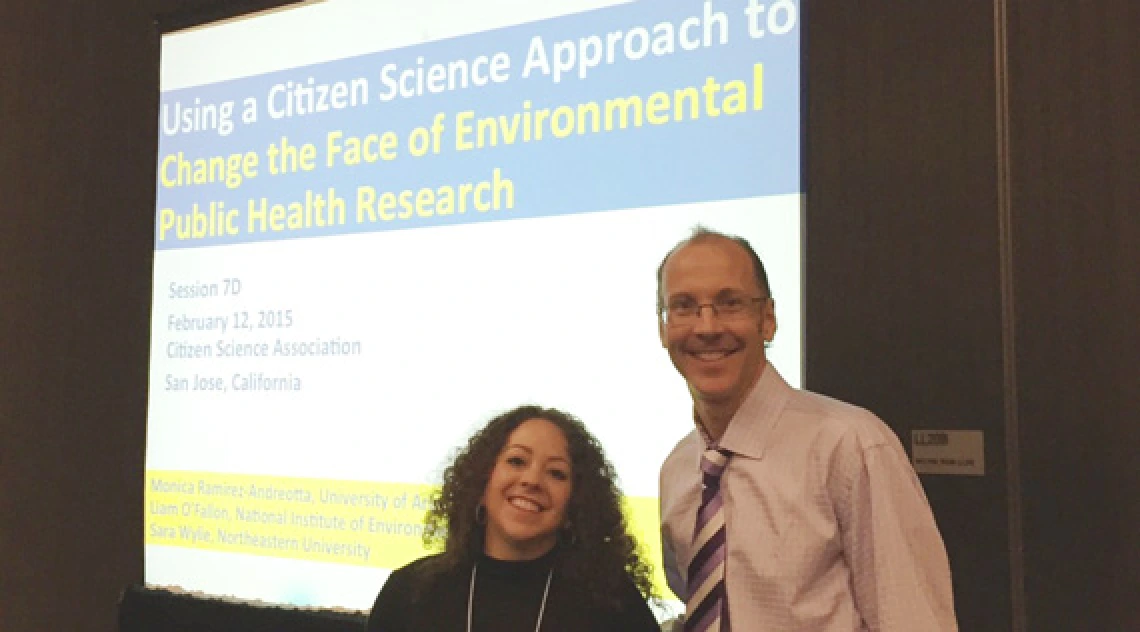UA SRP at the Citizen Science Conference 2015

 The Inaugural Conference of the Citizen Science Association was held February 11-12, 2015 in San Jose, CA. The conference addressed six major themes in the field of citizen science, ranging from addressing challenges to identifying best practices. The event, which was held as a pre-conference to the AAAS 2015 Annual Meeting, attracted over 600 attendees from 25 countries. Attendees included citizen science participants, researchers, educators, and evaluators, and represented a variety of scientific disciplines.
The Inaugural Conference of the Citizen Science Association was held February 11-12, 2015 in San Jose, CA. The conference addressed six major themes in the field of citizen science, ranging from addressing challenges to identifying best practices. The event, which was held as a pre-conference to the AAAS 2015 Annual Meeting, attracted over 600 attendees from 25 countries. Attendees included citizen science participants, researchers, educators, and evaluators, and represented a variety of scientific disciplines.
Monica Ramírez-Andreotta, a University of Arizona Superfund Research Program (UA SRP) associate investigator, and Assistant Professor in the UA Dept. of Soil, Water, and Environmental Science, was a member of the diversity and inclusion conference planning committee. In addition, she participated in three sessions. As a panelist in the Broadening Engagement to Foster Diversity and Inclusion panel, she and fellow members of the Citizen Science Association's Diversity and Inclusion Working Group discussed best practices for “Creating a Welcoming, Inclusive, Diverse and Just Citizen Science Association.”
 As Session Chair for the Best Practices for Designing, Implementing, and Managing Citizen Science Projects symposium, Ramírez-Andreotta and collaborators Sara Wylie (Northeastern University) and Liam O’Fallon (National Institutes of Environmental Health Sciences) presented on “Using a Citizen Science Approach to Change the Face of Environmental Public Health Research.” A highlight for the UA SRP was the inclusion of citizen scientists Rose Eitemiller (Community member and CEO, Community Coalition of Dewey-Humboldt, AZ) and Sandy Geiger (video presentation, Community member, Dewey-Humboldt, AZ), whose community is impacted by a Superfund site. In addition, Jody Roberts (Director, Institute for Research, Chemical Heritage Foundation) and Jennifer Carrera (Michigan State University) spoke about how a citizen science approach is informing their community-engaged research.
As Session Chair for the Best Practices for Designing, Implementing, and Managing Citizen Science Projects symposium, Ramírez-Andreotta and collaborators Sara Wylie (Northeastern University) and Liam O’Fallon (National Institutes of Environmental Health Sciences) presented on “Using a Citizen Science Approach to Change the Face of Environmental Public Health Research.” A highlight for the UA SRP was the inclusion of citizen scientists Rose Eitemiller (Community member and CEO, Community Coalition of Dewey-Humboldt, AZ) and Sandy Geiger (video presentation, Community member, Dewey-Humboldt, AZ), whose community is impacted by a Superfund site. In addition, Jody Roberts (Director, Institute for Research, Chemical Heritage Foundation) and Jennifer Carrera (Michigan State University) spoke about how a citizen science approach is informing their community-engaged research.
This was Eitemiller’s first time attending a national conference like this. She said she was happy to attend, both to support Ramírez-Andreotta’s work and to help her community. One improvement, she said, would be to “add more citizens, as it was a Citizen Science Forum. This way there is more feedback and questions from a less academic standpoint.” Eitemiller will be participating in another conference later this year, the annual US EPA Community Involvement Training Conference, and will provide a community perspective on transdisciplinary interactions at Superfund sites.
 In the Broadening Engagement to Foster Diversity and Inclusion symposium, Eitemiller and Ramírez-Andreotta, along with Patti Iwasaki (Taking Neighborhood Health to Heart), Jonathan Long (US Forest Service), Raj Pandya (Thriving Earth Exchange, American Geophysical Union), and Daniela Soleri (UC-Santa Barbara), were co-organizers and participants in a presentation and World Café discussion session entitled, “Pathways to Balance and Partnership: Advancing Equity, Inclusion, and Local Relevance in Citizen Science.” Ramírez-Andreotta provided a brief introduction to the topic, and turned it over to the community practitioners/experts, Eitemiller, Iwasaki and Long who then described their unique experiences with citizen science, including aspects such as barriers faced and community strengths.
In the Broadening Engagement to Foster Diversity and Inclusion symposium, Eitemiller and Ramírez-Andreotta, along with Patti Iwasaki (Taking Neighborhood Health to Heart), Jonathan Long (US Forest Service), Raj Pandya (Thriving Earth Exchange, American Geophysical Union), and Daniela Soleri (UC-Santa Barbara), were co-organizers and participants in a presentation and World Café discussion session entitled, “Pathways to Balance and Partnership: Advancing Equity, Inclusion, and Local Relevance in Citizen Science.” Ramírez-Andreotta provided a brief introduction to the topic, and turned it over to the community practitioners/experts, Eitemiller, Iwasaki and Long who then described their unique experiences with citizen science, including aspects such as barriers faced and community strengths.
When asked about her experience with the conference, Ramírez-Andreotta remarked that historically, citizen science has involved ecological studies, and stressed the need for community-engaged public health research efforts “to work across disciplinary boundaries to learn from one another and share lessons learned.” Her hopes for next year’s conference are to see “a stronger representation of environmental health citizen science efforts and more community members/citizen scientists presenting and attending sessions." Eitemiller echoed her sentiments for a greater environmental health focus.

